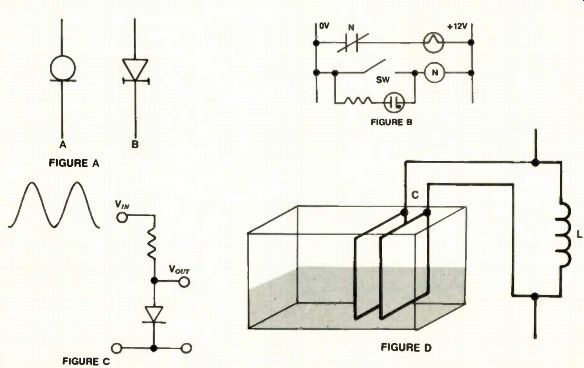By Sam Wilson, CET— Wilson is the electronics theory consultant it, ES&T.
Level of difficulty: high (50% is a high grade)
1. Which of the symbols in Figure A is used to represent a constant current diode? A. the one marked A B. the one marked B C. Neither is used for that purpose.
D. Both are used for that purpose.
2. In the ladder diagram shown in Figure B, the neon indicator lamp will light when switch SW is A. in the open position.
B. in the closed position.
C. Neither choice is correct.
3. A superheterodyne is a basic type of receiver. Name six other types.
4. Name four ways of coupling a signal from one amplifier to another.
5. Which of the following pairs of terms refer to the same kind of circuit?
A. synchronous detector/product detector
B. product detector/heterodyne detector
C. heterodyne detector/synchronous detector
D. All of the choices are correct.
6. Which of the following is an absolute requirement for an AM detector?
A. It must be linear so there is no distortion of the detected signal.
B. It must be non-linear so that the carrier can heterodyne with the sideband signal.
7. Assuming a perfect diode, which of the waveforms shown here is for the circuit in Figure C?
A. B. (A__( - OV
c. OV
D. r IT I.
8. Which of the following is an interface between a microprocessor system and the outside world?
A. PIO B. PIA C. Both answers are correct.
D. Neither answer is correct.
9. What does the letter I in PIN di ode stand for?
10. Two parallel metal plates are immersed in a tank of dielectric liquid as shown in Figure D. A parallel LC circuit is made using the resulting capacitor and an internal inductor. Assume there is no resistance in the circuit. The lowest resonant frequency for the circuit will occur when the liquid level is at the A. top of the container.
B. bottom of the container.

FIG. A
Answers:
1. D - both represent a constant current diode. You may have seen only one of these symbols, but you should know both.
2. C - neither. A neon lamp re quires about 65V to fire. The 12V ladder won't do it. Exchange the neon lamp for an LED.
3. Crystal (also known as crystal in put), regenerative, super regenerative, TRF, single conversion (also called homodyne), reflex. All of these types of receivers will be discussed in "What Do You Know About Electronics?" in future issues.
4. Direct coupling, transformer coupling, impedance coupling. R-C coupling.
5. D - all refer to the same kind of circuit.
6. B - it must be non-linear. You cannot heterodyne signals in a linear device.
7. C. On the positive half-cycle of in put. the diode conducts and there is OV across the output terminals. On the negative half-cycle, the diode represents an open circuit.
8. C - both are correct. Motorola calls it a PIA (peripheral interface adapter), but other manufacturers call it a PIO.
9. I stands for intrinsic. In other words, that material has no other material in it. You can call it pure.
10. A - the top of the container. The dielectric constant of air is 1.0, so when the tank is full, the dielectric constant is higher. That makes the capacitance higher and the frequency lower.